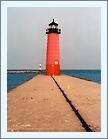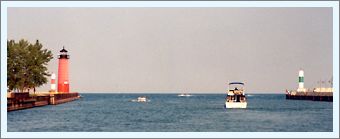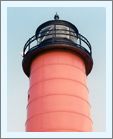|
Historical
Information

The first harbor improvements on Lake Michigan were undertaken at what
was then known as Southport in 1844 with
the erection of a pair of short timber piers on each side of the
channel. With the elongation of these piers in 1856, a squat 12-foot
tall timber-framed beacon was erected at the end of the north pier to
serve as a guide to mariners seeking harbor entry. Outfitted with a
Sixth Order Fresnel lens at a focal plane of 16 feet, the light was
visible for a distance of 9 miles at sea in clear weather.
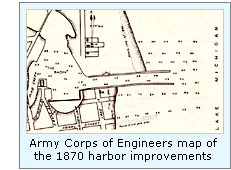 The beacon was carried away in a violent storm in 1860, and with the
country embroiled in the Civil War, funds were not authorized for its
replacement until 1862, and a temporary light was shown from a post on
the pier. With the end of the conflict in 1865, the Army Corps of
Engineers was dispatched to Kenosha to begin the work of improving the
harbor entrance through the refurbishment of the old timber piers and
dredging the harbor to an increased depth of 16 feet. With the work
progressing, the new beacon was finally reestablished on the end of the
end of the north pier in 1867. The new structure consisted of a
timber-framed pyramidal beacon standing 30 feet in height from its
foundation to focal plane. With a focal plane of 39 feet, the fixed red
Sixth Order Fresnel lens was visible for a distance of 12 miles. An
elevated timber walkway lead from shore to a door in the service room,
and allowed the keepers to access the light in relative safety when
storms pushed waves across the surface of the pier. The beacon was carried away in a violent storm in 1860, and with the
country embroiled in the Civil War, funds were not authorized for its
replacement until 1862, and a temporary light was shown from a post on
the pier. With the end of the conflict in 1865, the Army Corps of
Engineers was dispatched to Kenosha to begin the work of improving the
harbor entrance through the refurbishment of the old timber piers and
dredging the harbor to an increased depth of 16 feet. With the work
progressing, the new beacon was finally reestablished on the end of the
end of the north pier in 1867. The new structure consisted of a
timber-framed pyramidal beacon standing 30 feet in height from its
foundation to focal plane. With a focal plane of 39 feet, the fixed red
Sixth Order Fresnel lens was visible for a distance of 12 miles. An
elevated timber walkway lead from shore to a door in the service room,
and allowed the keepers to access the light in relative safety when
storms pushed waves across the surface of the pier.
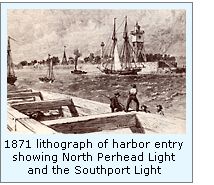 The Army Corps of Engineers continued their improvement work in the
harbor, and by 1870 the north pier had been extended to a total length
of 1,750 feet, with 800 feet of its length extending beyond the
shoreline. With continuing extension of the piers over the following
decade, with each extension, the beacon was picked up and relocated to
the new pierhead. To this end, the beacon was moved 320 feet in 1875,
105 feet in 1880, and 100 feet in 1881, and 150 feet in both 1883 and
1884, with the elevated walk lengthened a commensurate distance with
each move. The Army Corps of Engineers continued their improvement work in the
harbor, and by 1870 the north pier had been extended to a total length
of 1,750 feet, with 800 feet of its length extending beyond the
shoreline. With continuing extension of the piers over the following
decade, with each extension, the beacon was picked up and relocated to
the new pierhead. To this end, the beacon was moved 320 feet in 1875,
105 feet in 1880, and 100 feet in 1881, and 150 feet in both 1883 and
1884, with the elevated walk lengthened a commensurate distance with
each move.
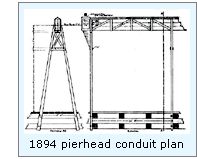 Making her way between the piers during a storm on November 20, 1891,
the schooner EVELYN ran into the beacon, damaging the watch room, with
all of its contents carried off by the seas. A work crew was hired, and
the damage quickly repaired. 1893 saw the erection of a lens lantern
atop a post at the outer end of the north pier to serve as a front range
104 feet ahead of the beacon, and the following year this post was
replaced by a 104-foot conduit was installed to allow the keeper to run
the light to and from the end of the pier from the protection of the
beacon watch room. The beacon was again damaged by a schooner of
unrecorded name on November 25, and again repairs were quickly effected. Making her way between the piers during a storm on November 20, 1891,
the schooner EVELYN ran into the beacon, damaging the watch room, with
all of its contents carried off by the seas. A work crew was hired, and
the damage quickly repaired. 1893 saw the erection of a lens lantern
atop a post at the outer end of the north pier to serve as a front range
104 feet ahead of the beacon, and the following year this post was
replaced by a 104-foot conduit was installed to allow the keeper to run
the light to and from the end of the pier from the protection of the
beacon watch room. The beacon was again damaged by a schooner of
unrecorded name on November 25, and again repairs were quickly effected.
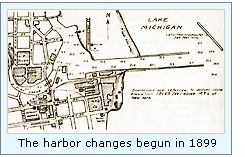 While the numerous extensions to the piers helped solve the problem
with sand build-up within the harbor, it was not as successful in
eliminating the typical Lake Michigan harbor entry sand bar at the end
of the piers, and thus constant dredging was required to keep the bar at
bay. The cycle of constant wetting and drying, combined with winter
freezes also continued to wreak their havoc on the timber piers. With
the older sections of the piers showing signs of major deterioration,
the end of the nineteenth century saw a cry rising in the local maritime
community for the Federal government to undertake additional harbor
improvements. On March 3,1899, the Engineers modified the harbor project
to including a widening of the channel, increasing its depth to 21 feet,
and the erection of an angled breakwater designed to stem the flow of
wave-born sand and thus minimize deposition in front of the piers.
During a gale that November 1, the conduit was completely obliterated,
and replaced by a post light 75 feet n front of the pierhead light five
days later. While the numerous extensions to the piers helped solve the problem
with sand build-up within the harbor, it was not as successful in
eliminating the typical Lake Michigan harbor entry sand bar at the end
of the piers, and thus constant dredging was required to keep the bar at
bay. The cycle of constant wetting and drying, combined with winter
freezes also continued to wreak their havoc on the timber piers. With
the older sections of the piers showing signs of major deterioration,
the end of the nineteenth century saw a cry rising in the local maritime
community for the Federal government to undertake additional harbor
improvements. On March 3,1899, the Engineers modified the harbor project
to including a widening of the channel, increasing its depth to 21 feet,
and the erection of an angled breakwater designed to stem the flow of
wave-born sand and thus minimize deposition in front of the piers.
During a gale that November 1, the conduit was completely obliterated,
and replaced by a post light 75 feet n front of the pierhead light five
days later.
With work progressing on the new breakwater in 1900, the decision was
made to erect a light on the southeastern end of the breakwater to serve
as a front range to the beacon on the north pier. While plans were in
place for a permanent structure, funding was unavailable, and a
temporary fixed red lens lantern was suspended from a brown iron pole
until the necessary appropriation for a more substantial became
available. Protected by a v-shaped structure of 12-inch square 18-foot
long timbers, the temporary breakwater light was placed into service on
the night of October 26, 1900.
With the harbor soon to be available to boats of the largest draft,
plans were also underway to both establish a fog signal on the north
pier and replace the old timber structure with a more durable cast iron
structure. At the opening of the 1901 navigation season, a work crew and
materials were delivered on the north pier, and set about enclosing the
lower level of the beacon to serve as housing for a blower siren powered
by a pair of 2-horsepower diesel engines, which were placed into
operation on April 25. While on the pier, the crew also replaced the
entire timber elevated walk with 1,040 feet of cast iron walkway.
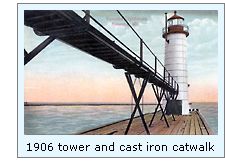 Materials for both the new breakwater light and north pier beacon
were delivered to the Milwaukee storehouse by June 30, however, with the
Army Corps of Engineers still working on the breakwater, and replacing
the north pier with preformed concrete caissons, the erection of the new
lights was postponed until harbor improvements were closer to
completion. Materials for both the new breakwater light and north pier beacon
were delivered to the Milwaukee storehouse by June 30, however, with the
Army Corps of Engineers still working on the breakwater, and replacing
the north pier with preformed concrete caissons, the erection of the new
lights was postponed until harbor improvements were closer to
completion.
Materials for the two new structures were delivered to Kenosha in
early 1906, and work began with the erection of the new pierhead light.
Consisting of riveted cast iron rings, with each layer slightly smaller
in diameter than the one immediately below, the tower tapered to a
circular iron gallery on which a cylindrical lantern with diagonal
astragals was centered. Capped by tapered conical roof, the structure
stood 50 feet from its base to the top of the ventilator ball. The
lantern was equipped with new flashing white Fourth Order
Fresnel lens. Access
to the tower from the iron elevated walkway was made through a door on
the second deck level. Immediately in front of the tower, a wood framed
rectangular pyramidal fog signal with horizontal wood clapboard siding
was erected, and connected to the tower by a covered passageway with a
door on one side through which entry to the fog signal could be gained.
Work on the north pier was completed, and after the ironwork was given a
fresh coat of white paint, the new Fourth Order lens exhibited for the
first time on the night of May 24, 1901.
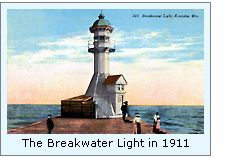 The work crew then turned its attention to the breakwater beacon.
Standing thirty five feet in height, the structure took the form of an
octagonal center column with its lower section tapered outward to form a
pyramidal service room sheathed in corrugated iron. A dormer on the east
side of the service room housed a door with a pair of windows above to
allow light into the interior. Integrated in the central octagonal
column, the lantern was capped by a large copper-clad dome supported by
sixteen corbels. Located at a focal plane of 37 feet, the 20 candlepower
fixed red lens lantern was visible for 6 miles in clear weather. While
the appearance of this light appears unique, there were four similar
structures built during the same time period at Petoskey, Racine,
Waukegan and Sheboygan. The work crew then turned its attention to the breakwater beacon.
Standing thirty five feet in height, the structure took the form of an
octagonal center column with its lower section tapered outward to form a
pyramidal service room sheathed in corrugated iron. A dormer on the east
side of the service room housed a door with a pair of windows above to
allow light into the interior. Integrated in the central octagonal
column, the lantern was capped by a large copper-clad dome supported by
sixteen corbels. Located at a focal plane of 37 feet, the 20 candlepower
fixed red lens lantern was visible for 6 miles in clear weather. While
the appearance of this light appears unique, there were four similar
structures built during the same time period at Petoskey, Racine,
Waukegan and Sheboygan.
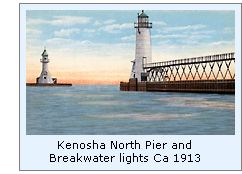 On July 27, 1912, the breakwater light was converted to acetylene
power and the characteristic modified from fixed red to flashing white
every three seconds. The following year, the lamp within the north
pierhead light was also upgraded to an incandescent oil vapor lamp. The
north pier light was given a coat of red paint in 1917, and the
characteristic of the light changed back to red, only this time it was
converted to an occulting characteristic of a 2.5 second flash followed
by 12.5 seconds of darkness. On July 27, 1912, the breakwater light was converted to acetylene
power and the characteristic modified from fixed red to flashing white
every three seconds. The following year, the lamp within the north
pierhead light was also upgraded to an incandescent oil vapor lamp. The
north pier light was given a coat of red paint in 1917, and the
characteristic of the light changed back to red, only this time it was
converted to an occulting characteristic of a 2.5 second flash followed
by 12.5 seconds of darkness.
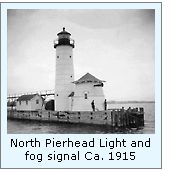 The 1906 breakwater light was removed from the breakwater in 1921,
and replaced by a 37 foot tall red skeletal steel tower with its lower
end enclosed, similar in design to that currently in existence on the
Muskegon south breakwater. All lights were electrified in 1925, and the
fog signal equipment upgraded to an air-operated diaphone powered by an
Ingersoll-Rand air compressor. Three years later, the end of the south
pier was marked with a steel pyramidal day mark, which was illuminated
at night by a searchlight located on the pierhead. The 1906 breakwater light was removed from the breakwater in 1921,
and replaced by a 37 foot tall red skeletal steel tower with its lower
end enclosed, similar in design to that currently in existence on the
Muskegon south breakwater. All lights were electrified in 1925, and the
fog signal equipment upgraded to an air-operated diaphone powered by an
Ingersoll-Rand air compressor. Three years later, the end of the south
pier was marked with a steel pyramidal day mark, which was illuminated
at night by a searchlight located on the pierhead.
A some time during the 1960ís, both the breakwater and south pier
lights were replaced by cylindrical D-9 towers, and while the 1906 north
pierhead light still serves as an active aid to navigation, the fog
signal building and elevated walk are long since gone, and the light is
now displayed from a 250 mm Tidelands Signal
optic.
Keepers of this Light

Click
Here to see a complete listing of all Kenosha Pierhead Light
keepers compiled by Phyllis L. Tag of Great Lakes Lighthouse Research.

Seeing this Light

From I-94, head east on Hwy 158, which eventually becomes 52nd street as it crosses the City limits, to Sheridan Road. Turn left (North) on Sheridan Road to 50th Street, turn right (East) on 50th Street to Simmons Island Park. Bear to the right after crossing the bridge to the island, pass the Southport lighthouse on your left, and continue around the perimeter of the island to the parking lot at the foot of the pier.

Reference Sources

Annual reports of the Lighthouse Board,
various, 1856 - 1909
Annual reports of the Lake Carrier's Association, various, 1906 -
1940
Great Lakes Light Lists, various, 1861 - 1953
US Army Corps of Engineers Archives, various drawings, Chicago
District
Photographs from author's personal collection.
Personal observation at Kenosha, 09/08/2000.
Keeper listings for this light appear courtesy of Great
Lakes Lighthouse Research
|
